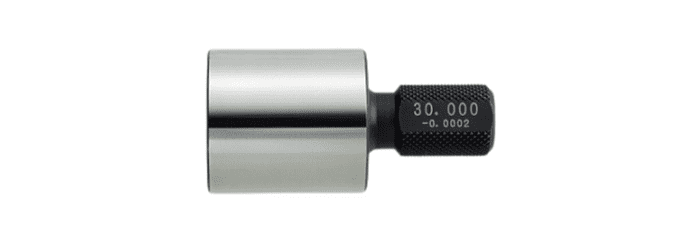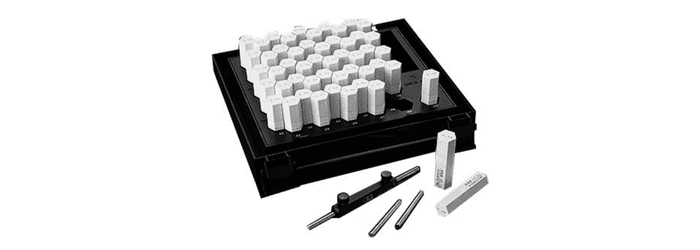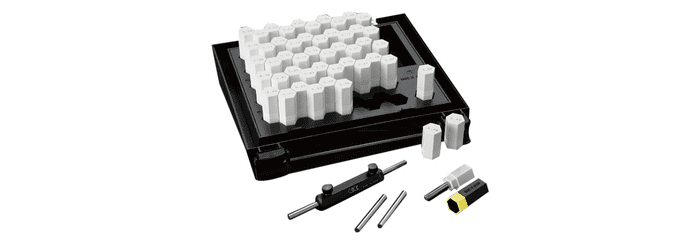The plug gauge is a measuring inspection tool to check the inner diameter of holes. After producing a component, it is important for you to check and find out whether the component is produced within the specified tolerance, this is where the plug gauge comes into play. They are one of the most widely used measuring tools in the manufacturing industry to check the diameter of a component. The plug gauge is an inspection tool that is manufactured with precision and has very tight tolerances. This article provides information about the functions, types, uses, tolerances, configurations and plug gauge products sold by us in Singapore.
What is Plug Gauge?
The plug gauge is a metrology tool used to check the accuracy of internal diameters of holes. They can sometimes also come in the form of pin gauges. It consists of two wear-resistant steel cylinders which are sized to the limit value of the hole's dimensions. As a bore checker, plug gauges are a crucial tool for quality control and allow inspectors, engineers, manufacturing engineers, and others to quickly make a “Go” or “No-Go” decision. They are used to determine whether the characteristics of the part being measured are within the dimensional tolerance specified.
A “Go” or “No-Go” plug gauge is also called a single ended plug gauge and consists of a pin or machine shaft grip used to verify the dimensional tolerance aspect of the bore. To measure single ends, plug gauges are usually made in pairs, one “Go” gauge and one “No-Go” gauge.
Function
The plug gauge is used to check the dimensions of the inner diameter of a hole, whether it is within the tolerance specified. When the hole is found to be within the tolerance, production can then be continued. This checking process is designed to get an accurate assessment without requiring the production side to use additional measuring tools, which tend to be more sophisticated and expensive such as an internal micrometer.
In production, where parts are produced in massive quantities, plug gauges provide a quick way to assess the quality of a workpiece by inspecting actual hole diameters.
Types of Plug Gauge
Plug gauges are available in several types, namely:
1. Plug gauge “Go” (lower hole gauge)
The “Go” plug gauge is manufactured to check the minimum limit of a hole's dimension, i.e. the tolerance lower than the hole diameter which represents the maximum amount of material remaining in the work part or component.
For acceptance condition, the plug gauge must fit snugly into the hole. If the plug gauge does not fit into the workpiece's hole, this is an indication that the hole diameter is too small (the amount of material removed from the working part is not sufficient) and the part needs to be rejected.
2. Plug gauge “No-Go” (upper hole gauge)
The function of a “No-Go” plug gauge is to validate the maximum hole dimension limit (tolerance over hole diameter) which corresponds to the minimum acceptable amount of material remaining in the work part or component.
For the part to be accepted by quality control, the plug gauge must not be able to enter the hole. If the plug gauge does not fit into the hole, then this is an indication that the hole diameter is below the upper limit and the section is acceptable (provided the “Go” plug gauge goes into the hole). However, if a “No-Go” plug gauge can enter the hole, then it is an indication that the hole diameter is too large (i.e. outside the specified upper tolerance limit), which means that too much material is being removed during the machining operation, and therefore that part must be rejected.
These conditions are summarized in Table 1.
Table 1. Conditions for using “Go” / “No-Go” plug gauge
|
Plug gauge “Go” |
Plug gauge “No-Go” |
Status |
Condition |
|
Fits |
Doesn't Fit |
Accept Part |
Hole diameter inside tolerance band |
|
Does not fit |
Doesn't Fit |
Reject Part for Rework |
Hole diameter below the minimum value |
|
Fits |
Fits |
Reject Part & Scrap |
Hole diameter above the maximum value |
3. Combination of “Go” / “No-Go” plug gauge
In a combination "Go" / "No-Go" plug gauge (also known as a double-ended plug gauge), the plug gauge has a "Go" section extending outward from one side of the handle and a "No-Go" section extending outward from the opposite side. This makes the tool simpler and allows the inspection process to run faster.
On some models, the handles are color coded, the “Go” section is painted green and the “No-Go” section is painted red. Even without color coding, “Go” gauge plugs can always be distinguished from “No-Go” gauge plugs under two observable conditions:
- “Go” gauge plugs are always smaller in diameter than “No-Go” gauge plugs.
- “Go” gauge plugs always have a larger width (thickness) than “No-Go” gauge plugs.
Application
Plug gauges provide quick results and users can learn to use it with minimal training as the plug gauge is remarkably simple to use. You would not require deep knowledge of scientific methods and metrology to use the plug gauge. The simplicity of its use opens the tool up to a wider group of users. It further makes this tool inexpensive compared to other measuring tools.
One of the disadvantages of plug gauges is that they tend to wear out over time and need to be replaced. The plug gauge should also be checked periodically to ensure that it is within tolerance limits.
Plug Gauge Tolerance
Plug gauges are available in a variety of tolerance classes that can be selected according to the specific requirements of the application and the need for precision. We normally use ISO engineering fits to describe plug gauges as it is the internationally accepted standard for defining engineering fits. However, ANSI is still often used in North America region.
The ISO System of Limits and Fits is a coordinated system of hole and shaft tolerances for engineering and manufacturing used for gauges. If held to these tolerances, gauges are available throughout the world. The hole basis fits have hole tolerances like H11, H9, H8, and H7 for instance; the shaft basis fits have shaft tolerances like h11, h9, h7, and h6 for instance.
Below is an example of some common tolerances for nominal diameter sizes 0 to 30 mm.
| Tolerance | Tolerance2 | over 0 to 3 | over 3 to 6 | over 6 to 10 | over 10 to 18 | over 18 to 24 | over 24 to 30 |
| Shafts | h6 | 0.000 -0.006 | 0.000 -0.008 | 0.000 -0.009 | 0.000 -0.011 | 0.000 -0.013 | 0.000 -0.013 |
| Shafts | h7 | 0.000 -0.010 | 0.000 -0.012 | 0.000 -0.015 | 0.000 -0.018 | 0.000 -0.021 | 0.000 -0.021 |
| Shafts | h9 | 0.000 -0.025 | 0.000 -0.008 | 0.000 -0.009 | 0.000 -0.011 | 0.000 -0.013 | 0.000 -0.013 |
| Shafts | h11 | 0.000 -0.060 | 0.000 -0.075 | 0.000 -0.090 | 0.000 -0.110 | 0.000 -0.130 | 0.000 -0.130 |
| Holes | H7 | +0.010 0.000 | +0.012 0.000 | +0.015 0.000 | +0.018 0.000 | +0.021 0.000 | +0.021 0.000 |
| Holes | H8 | +0.014 +0.000 | +0.018 +0.000 | +0.022 +0.000 | +0.027 +0.000 | +0.033 +0.000 | +0.033 +0.000 |
| Holes | H9 | +0.025 +0.000 | +0.030 +0.000 | +0.036 +0.000 | +0.043 +0.000 | +0.052 +0.000 | +0.052 +0.000 |
| Holes | H11 | +0.060 0.000 | +0.075 0.000 | +0.090 0.000 | +0.110 0.000 | +0.130 0.000 | +0.130 0.000 |
On the other hand, standards found In Measurement of Plain External Diameters for use as Master Discs or Cylindrical Plug Gages, B89.1.5 – 1998, published by the American Society of Mechanical Engineers, plug gauges are typically rated to the following levels:
1. Class XX
This gauge has an inch tolerance of 0.00002” and a metric tolerance of 0.0005 mm.
2. Class X
This gauge has an inch tolerance of 0.00004” and a metric tolerance of 0.001 mm.
3. Class Y
This gauge has an inch tolerance of 0.00007” and a metric tolerance of 0.0018 mm.
4. Class Z
This gauge has an inch tolerance of 0.0001” and a metric tolerance of 0.0025 mm.
5. Class ZZ
This gauge has an inch tolerance of 0.0002” and a metric tolerance of 0.005 mm.
Standard practice for plug gauges is to set a tolerance of plus 5% of the product bore tolerance to the “Go” gauge plug and a minus 5% tolerance to the “No-Go” gauge plug, for a total band tolerance of 10%
Plug Gauge Configuration and Material Options
Plug gauges come in several configurations making them suitable for different uses. Plain plug gauges are used to check dimensional tolerances in bore holes drilled with smooth walls. There is also thread plug gauges which are used to check threaded holes, and verify the correct thread type, main diameter, minor diameter, pitch diameter, and thread pitch against a mating thread gauge. As with ring gauges, some gauge plugs called master sets or master plugs are not used as working gauges but are used to validate other measuring instruments such as bore gauges or external micrometers.
For example, by providing measurement standards or reference standards for calibration purposes. This practice is known as indirect measurement.
The plug gauge also includes the following:
- On a worn plug gauge there is usually a black oxide layer that shows a wear pattern when the tool is used, making it easier to determine when the tool needs to be replaced.
- Plug gauge set, where various gauge sizes are offered in a case or cabinet.
- The target gauge plug gauge allows the user to specify the target gauge size and type (“Go” or “No-Go”).
- Thread plug gauge for NPT threaded pipe allows the user to verify the internal thread in threaded pipe joints.
- The thread plug gauge handle allows the user to swap gauge sizes.
- Hexalobe plug gauge used to check fit and cut tolerances on 6 point star shaped patterns.
Plug gauges are typically manufactured using high grade tool steel such as 52100. This option provides corrosion resistance due to the high chromium content of the steel and reduces friction during use which helps extend tool life.
Tungsten carbide gauges offer high wear resistance, about 50x that of tool steel. In addition, it is non-magnetic, resistant to corrosion, and will not burr. However, tungsten carbide has a low coefficient of thermal expansion, so tighter temperature control is required when using tools of this material to measure steel parts with tight tolerances.
A chrome plated gauge plug will also provide a harder surface and can be used to measure abrasive materials such as magnesium or aluminum.
Plug Gauge & Pin Gauge Available at LFC
1. Ojiyas Limit Plug Gauge (Plain Gauge)
Plug gauges are used to check the inside diameters of parts. They are cylindrical in shape and come in pairs, Go and No-Go. One of them has a dimension at the maximum limit, the other is at a minimum limit. This is according to the size of the hole the gauge is to inspect. The plug gauge will ensure the interchangeability of engagement between the hole and the shaft.
2. Ojiyas Master Plug Gauge
Ojiyas master gauges are used for comparative gauging as well as for checking, calibrating, or setting of gauges or other standards and maintaining comparator type of measuring instruments. For instance, cylinder gauges, bore gauges and air micrometers use a master gauge for setting.
3. Eisen Pin Gauge EP Series Set
Eisen Pin Gauge EP Series Set is a pin gauge set in increments of 0.01 mm within the range size 0.05 mm to 20 mm. There are two different sets; Class-0 (set range 0.2 mm to 10 mm) and Class-1 (set range 0.05 mm to 20 mm). Eisen Pin Gauge EP Series Set Class 0 have ± 0.5 μm tolerance for your micron precision assurance. Each set can be used as basic go/no go gauge to determine small hole sizes, for gaging slots, and finding hole distances precisely. Nominal sizes are printed on each cap on 0.20-1.49 mm gauge, meanwhile for gauges over 1.50 mm, the nominal sizes are laser cut into each gauge.
4. Eisen Pin Gauge Ceramic ECS Series Set
Eisen Pin Gauge ECS Series Set is package of pin gauges made from fine ceramics zirconium dioxide (ZrO2; also known as zirconia) for various precision measurement. The linear expansion characteristics of zirconia are close to steel, and the high-density zirconia is not easily broken or chipped. The size range of Eisen Pin Gauge ECS Series start from 0.2 mm through 20 mm. This set also comes with a handle to significantly insulate against heat and reduce the time required for repeated measurements. Eisen Pin Gauge ECS Series Set Zirconia is 8.5 on the Mohs scale of mineral hardness, compared to 4.5 for normal steel and 7.5 to 8 for hardened steel and 10 for diamond.
5. Eisen Pin Gauge Tungsten Carbide EG Series
Eisen Pin Gauge EG series contains 51 pin gauges made from tungsten carbide that have up to ± 1 μm tolerance for high precision measurements in micron units. Each standard size increases by 0.01 mm increments and all pin gauges are 58 HRC or harder. Custom sizes and combinations can also be made to meet unique customer needs. Sizes are indicated on the plastic cases for gauges up to 1.49mm and are laser engraved on gauges 1.50mm and larger.
Plug Gauge Distributor in Singapore
LFC PTE LTD is the official distributor of Ojiyas & Eisen in Singapore. If you would like to discuss further measurement applications, please contact us.
You can also find out more about the Ojiyas products by viewing the Ojiyas catalog on our website.
Visit our facebook, instagram, youtube and linkedin pages to get the latest updates about industrial equipment.
Reference:
1. All about plug gauges - definition, sizes, and uses. Thomasnet® - Product Sourcing and Supplier Discovery Platform - Find North American Manufacturers, Suppliers and Industrial Companies. (n.d.). Retrieved August 30, 2022, from https://www.thomasnet.com/articles/instruments-controls/all-about-plug-gauges/
2. Wikimedia Foundation. (2022, August 15). Engineering fit. Wikipedia. Retrieved August 30, 2022, from https://en.wikipedia.org/wiki/Engineering_fit#Types_of_fit
3. Iso Standards handbook. (1999).

1.png)






